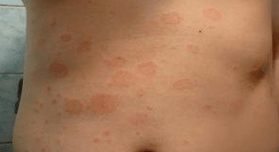What is psoriasis and what appears?Psoriasis is the non -infectious condition of the skin, whose result is red -fiery, as well as dry scales - the result of excessively rapid growth of skin cells.The disease usually affects the skin on elbows, knees and scalp.
In some people, this manifests itself smoothly, the symptoms are practically absent.Others observe serious symptoms, frequent relapses.That is psoriasis, where it comes from, why it seems, the causes of appearance, how they are infected - we will try to answer these and other questions on the pages of our portal.

Psoriasis is an incurable and long (chronic) condition of the skin.Exacerbation stages are rapidly replaced by stages of improvement.Many patients observe the worsening symptoms from November to February (winter months), as well as hot summer time.Psoriasis affects all ethnic races and representatives of both sexes.Although psoriasis may appear in people of any age - from babies to elderly - most of the time the disease is diagnosed in adolescence under 20 years.
At what age does psoriasis appear?The disease is rare in babies (less than 4% of patients) in children, psoriasis can manifest if parents are carried to the disease.Psoriasis in children such young is often preceded by acute pharyngitis, tonsillitis, bronchitis or respiratory infection, for example, cold, influenza or pneumonia.People with psoriasis are more likely to get diabetes, hyperlipidemia and heart disease.
Why does psoriasis occur?The causes of psoriasis are unknown to the end, but usually the disease is associated with the problem of the immune system.What and how does psoriasis appear?The key element is a special type of lymphocytes, so-called t or t cells. As a rule, these white blood cells move all over the body to detect and eliminate strange substances such as viruses or parasites (Streptococcus).However, in patients with psoriasis, T lymphocytes erroneously attack healthy skin cells (to combat a false infection).
Hyperactive lymphocytes cause immunological reactions, including expansion and increased vessels around the papules and pustules of Pasriia.These changes lead to an increase in the production of healthy skin cells and other white blood cells.This causes a ongoing cycle, against which new skin cells move to the upper layers of the epidermis - in a matter of days.
The researchers also found genes associated with psoriasis development, proving that the disease is inherited, but external environmental factors (physical, chemical effect, skin thermal) and internal (stress, unbalanced nutrition, day and sleep, infection, excessive/regular use of alcohol and smoking) also play a certain role.
Signs and symptoms
Psoriasis manifests itself in the form of red or pink scaly cones that merge into large papules (plates) of the skin.Sometimes, when combing these small dry white scales, slight bleeding occurs.
There are several types of psoriasis - not pustular (affects large areas of the skin) and pustular (rarer form, usually manifested in hands or legs).The rash can have several contours and shapes of point and rocky to a visible monetary.
First signs of psoriasis are increased fatigue, weakness throughout the body, sometimes a slight dizziness, bad -staring.As rashes develop and increase, symptoms such as itching, burning, pain, sometimes fever and chills are added.
Stages
In the absence of treatment, psoriasis develops rapidly.In the early stages, small pink or reddish scales appear on the skin (which are usually located symmetrically, for example, in both hands, the points will be located in the same way).Also, on top of reddish points, a scaly layer of surface begins to develop.

This is keratinized skin, which is easily removed independently.After the formation of scales, the reddish points gather in large red signs, this stage is accompanied by serious itching and burning, as well as peeling the skin.
Exacerbation
The aggravation stage is characterized by the occurrence of large (usually swollen) spots on the skin (plate, dad), severe itching, burning, often pain.The area of disease propagation also increases markedly (plates become more than 10 cm in diameter).A peculiar feeling of tightness on the skin appears.By moving the disease to the exacerbation stage, you should contact a specialist immediately.During this stage, cracks appear on the skin (due to tension, dryness and keratinization).
Life danger
During the aggravation stage, keratinized dry areas crack, the skin begins to bleed and becomes more susceptible to infections, which causes the appearance of new plates (Köbner syndrome).
The most serious consequence of exacerbation may be psoriatic arthritis (the disease will spread through bones and joints and cause its inflammation and deformation) or psoriatic erythroderm (a very severe incurable skin disease that can lead to death).
Psoriasis remains one of the most complex skin diseases.A wide range of procedures available for the treatment of psoriasis illustrates this.It is very important to take steps to restrict the disease and prevent it from going to the exacerbation stage, so it is necessary to seek help from an expert, besides changing your lifestyle, resorting to drugs and methods of traditional medicine.























